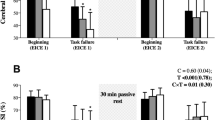Abstract
The purpose of this study was to use a hypoxic stress as a mean to disrupt the normal coordinative pattern during cycling. Seven male cyclists pedalled at three cadence (60, 80, 100 rpm) and three power output (150, 250, 350 W) conditions in normoxia and hypoxia (15% O2). Simultaneous measurements of pedal force, joint kinematics, % oxyhaemoglobin saturation, and minute ventilation were made for each riding condition. A conventional inverse dynamics approach was used to compute the joint moments of force at the hip, knee, and ankle. The relative contribution of the joint moments of force with respect to the total moment was computed for each subject and trial condition. Overall, the ankle contributed on average 21%, the knee 29% and the hip 50% of the total moment. This was not affected by the relative inspired oxygen concentration. Results showed that the relative ankle moment of force remained at 21% regardless of manipulation. The relative hip moment was reduced on average by 4% with increased cadence and increased on average by 4% with increased power output whereas the knee moment responded in the opposite direction. These results suggest that the coordinative pattern in cycling is a dominant characteristic of cycling biomechanics and remains robust even in the face of arterial hypoxemia.






Similar content being viewed by others
References
Amann M, Eldridge MW, Lovering AT, Stickland MK, Pelegow DF, Dempsey JA (2006a) Arterial oxygenation influences central motor output and exercise performance via effects on peripheral locomotor muscle fatigue in humans. J Physiol 575(3):937–952
Amann M, Romer LM, Pegelow DF, Jacques AJ, Hess CJ, Dempsey JA (2006b) Effects of arterial oxygen content on peripheral locomotor muscle fatigue. J Appl Physiol 101:119–127
Amann M, Romer LM, Subudhi AW, Pegelow DF, Dempsey JA (2007) Severity of arterial hypoxemia affects the relative contributions of peripheral muscle fatigue to exercise performance. J Physiol 581(1):389–403
Dousset E, Steinberg JG, Balon N, Jammes Y (2001) Effects of acute hypoxemia on force and surface EMG during sustained handgrip. Muscle Nerve 24:364–371
Ericson MO (1988) Mechanical muscular power output and work during ergometer cycling at different work loads and speeds. Eur J Appl Physiol Occup Physiol 57:382–387
Ericson MO, Ekholm J, Svensson O, Nisell R (1985) The forces of ankle joint structures during ergometer cycling. Foot Ankle 6:135–142
Ericson MO, Bratt A, Nisell R, Nemeth G, Ekholm J (1986) Load moments about the hip and knee joints during ergometer cycling. Scand J Rehabil Med 18:165–172
Fulco CS, Rock PB, Cymerman A (1998) Maximal and submaximal exercise performance at altitude. Aviat Space Environ Med 69:793–801
Hogan MC, Richardson RS, Haseler LJ (1999) Human muscle performance and PCr hydrolysis with varied inspired oxygen fractions: a 31P-MRS study. J Appl Physiol 86:1367–1373
Hull ML, Jorge M (1985) A method for biomechanical analysis of bicycle pedalling. J Biomech 18:631–644
Kjaer M, Hanel B, Worm L, Perko G, Lewis SF, Sahlin K, Galbo H, Secher NH (1999) Cardiovascular and neuroendocrine responses to exercise in hypoxia during impaired neural feedback from muscle. Am J Physiol 277:R76–R85
Marsh AP, Martin PE, Sanderson DJ (2000) Is a joint moment-based cost function associated with preferred cycling cadence? J Biomech 33:173–180
Mateika JH, Duffin J (1994) The ventilation, lactate and electromyographic thresholds during incremental exercise tests in normoxia, hypoxia and hyperoxia. Eur J Appl Physiol 69:110–118
Redfield R, Hull ML (1986a) On the relation between joint moments and pedalling rates at constant power in bicycling. J Biomech 19:317–329
Redfield R, Hull ML (1986b) Prediction of pedal forces in bicycling using optimization methods. J Biomech 19:523–540
Romer LM, Haverkamp HC, Amann M, Lovering AT, Pegelow DF, Dempsey JA (2007) Effect of acute severe hypoxia on peripheral fatigue and endurance capacity in healthy humans. Am J Physiol Regul Integr Comp Physiol 292:R598–R606
Sanderson DJ, Black A (2003) The effect of prolonged cycling on pedal forces. J Sports Sci 21:191–199
Sanderson DJ, Hennig EM, Black AH (2000) The influence of cadence and power output on force application and in-shoe pressure distribution during cycling by competitive and recreational cyclists. J Sports Sci 18:173–181
Sandiford SD, Green HJ, Duhamel TA, Schertzer JD, Perco JD, Ouyang J (2005) Muscle Na–K-pump and fatigue responses to progressive exercise in normoxia and hypoxia. Am J Physiol Regul Integr Comp Physiol 289:R441–R449
Taylor AD, Bronks R, Smith P, Humphries B (1997) Myoelectric evidence of peripheral muscle fatigue during exercise in severe hypoxia: some references to m. vastus lateralis myosin heavy chain composition. Eur J Appl Physiol 75:151–159
Zajac FE, Neptune RR, Kautz SA (2002) Biomechanics and muscle coordination of human walking. Part I: introduction to concepts, power transfer, dynamics and simulations. Gait Posture 16:215–232
Acknowledgments
We would like to thank our subjects for their enthusiastic participation. This study was supported by the Natural Sciences and Engineering Research Council (NSERC) of Canada. J. A. Guenette was supported by graduate scholarships from NSERC, the Michael Smith Foundation for Health Research (MSFHR) and the Alberta Heritage Fund. A. W. Sheel was supported by a Scholar Award from the MSFHR and a New Investigator award from the Canadian Institutes of Health Research.
Author information
Authors and Affiliations
Corresponding author
Rights and permissions
About this article
Cite this article
Mornieux, G., Guenette, J.A., Sheel, A.W. et al. Influence of cadence, power output and hypoxia on the joint moment distribution during cycling. Eur J Appl Physiol 102, 11–18 (2007). https://doi.org/10.1007/s00421-007-0555-z
Accepted:
Published:
Issue Date:
DOI: https://doi.org/10.1007/s00421-007-0555-z




